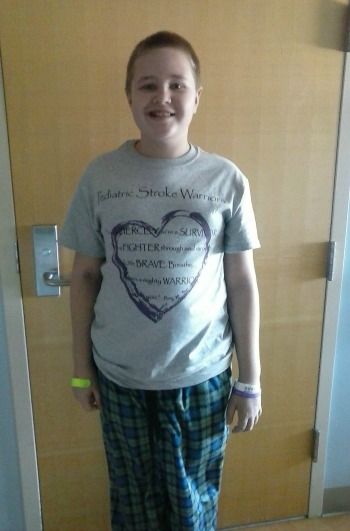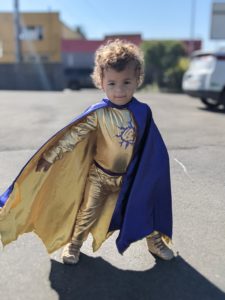Meet Alex — Stroke at age 12
October 31st, 2015. Our family dressed up as superheroes for Halloween: Iron Man, Batman, Spiderman, The Hulk, and Captain America. Little did we know that in 24 hours our 12 year-old son would be fighting for his life like a true blue super hero.

Sunday, November 1st, 2015 started out as another normal Sunday in our house. Alex went to church with his friends, our oldest daughter and my husband went to work, and our second daughter stayed home with me to help clean up before the grandparents showed up later that day. Right before the clock would hit midnight on this day I would hear the unthinkable: “your son has suffered a massive ischemic STROKE.” Those words are deafening.
After coming home from church, Alex went for a bike ride. Less than 30 minutes after arriving home, Alex suddenly complained of a terrible headache. We sent him into the other room for ibuprofen, and I’d learn later from his accounts that he barely reached the couch when he collapsed, fell on the couch, and off onto the floor. I don’t know exactly how long it took before I came to check on him – five minutes, 10 minutes… Those are just the first of many questions I’ll never have answers to. The fact is that when I did go in and check on him, I thought he was being melodramatic. “What are you doing, lying on the floor?” I asked him. “Trying to get the ibuprofen open,” he said. I thought it odd, but I just said “Ok, I’ll open it, you just have to ask.” Then I began to notice his right leg was twitching, kicking. I began to suspect something wasn’t right. I asked, “Why are you kicking your leg?” “I don’t know,” he replied. “Alex get up,” I began. He tried to sit up, but his whole left side was obviously not working. I looked at his face and the left side of his mouth just hung, drool was dripping down his face, and his eyes seemed to be stuck looking to one side. Something was terribly wrong.
I have never called 911 before, never rushed my children to the emergency room; it’s an experience I never want to repeat. The first thoughts that come to your mind is, “what is it?, why is it?, and how do you stop it?” We saw clear indicators that it was something with his brain. Though our first responders and local ER doctors were diligent, they had no idea that children can have a stroke. When we called 911, we specifically told them he was having stroke-like symptoms. We were told he was probably just having a seizure. F.A.S.T. (Face drooping, Arm weakness, Slurred speech, Time to call 911) is something my husband and I had known about subconsciously, never knowing we would truly need that information for our own son. Our local ER doctors started Alex on anti-seizure medicine and did a quick cat scan. After ruling out brain bleed, our local doctor began to tell us that hopefully it is just a terrible migraine and that he would recover shortly. I knew in my heart that though he had a terrible headache, a migraine would not cause the paralysis and visual and facial changes that he was presenting.
Living in a very rural community has its perks and downfalls, That day we experienced the biggest downfall of our area. Alex’s stroke occurred around 3:00 pm. We were not life-flighted to Denver Children’s hospital until nearly 8:00 pm. There are no words to describe the thoughts that run through your mind as you are taking a direct flight sitting next to your unconscious child strapped down on a gurney. Shortly after arriving in yet another ER, we were rushed in for Alex’s first MRI. Just before midnight, the doctors finally had an answer. Alex had suffered a very large ischemic stroke on the right side of his brain. Something had blocked one of his blood vessels and the next 3 days would be the most critical to assess the damage done. The time delay limited the help the doctors could give. Before this day, it never occurred to me that a child could suffer a stroke. Yet, here was our son, a 12 year-old who had no prior medical problems, laying on a hospital bed. To this day, we will probably never know what caused Alex’s stroke. That is one of the most difficult things to live with – the unknown.
Only a week later, we would find out that Alex had suffered yet another stroke and he was presenting with a rare autoimmune disease; Primary Central Nervous System Vasculitis. (Central nervous system (CNS) vasculitis is inflammation of blood vessel walls in the brain or spine.) Because the disease presented after the first stroke, it is not believed to be the cause but a reaction to the initial stroke. Alex remained in the Pediatric ICU for a week during which his body showed little to no recovery. Doctors believed he would never walk again or have use of his left hand and he may never see the left side of his world. Life was never going to be the same.
After being released from the PICU, Alex was transferred to the in-patient rehab floor where he began intensive therapy. He had a busy schedule with speech, occupational, and physical therapists, and he also began daily school times to reintroduce him to a classroom setting and interact with others. He would spend six weeks in this program before going home and beginning his work with outpatient therapy.
We were lucky that Alex is a fighter and always kept pushing forward. No matter what he was asked to do, or try, he would give it his all. He truly is a Superhero. He has embraced his Captain America persona wholeheartedly. Within the first few weeks, he was up and out of the wheelchair, using a cane, and a few weeks later, he was fully walking unassisted. When Alex walked out of Denver Children’s Hospital on December 10th, 2015, he was able to close his left hand and begin raising is up toward his face. By the new year he was opening and closing his hand and to date is working on his grasping skills.
Living with a special needs or disabled child is, at the very least, difficult. Your whole world changes. Things you once did have to be changed, fined-tuned to accommodate the “new normal”. Alex is on blood thinners and aspirin as the blood thinners alone were not enough to keep his blood thin enough to move through the vasculitis. These daily shots leave large bruises and can bleed up to 36 hours. Due to his excessive bleeding and bruising, we use a catheter to give his medication. These catheters can be used up to seven days before we have to change injection sites. The injection sites must be rotated so that it doesn’t create lumps under the skin. He has monthly blood draws to make sure his blood is remaining in the expectable range for optimum blood flow. Alex has also been on high dose steroids since week two. The steroids can cause insomnia along with causing over 30 pounds of weight gain. He must remain on these steroids until he is switched to a steroid-reducing medication. These medications are to control the Vasculitis and he will remain on them for several years. The side effects are not pretty, but are less of a risk than the long-term steroid use, which can include brittle bones and growth and hormonal issues.
Alex continues to have four therapies a week, which include pool and land physical therapy and two sessions of occupational therapy. He tries to go to school for approximately two hours a day, where he is learning to socialize again and focus on his reading and math skills. While in class, he has a dedicated teacher’s assistant who helps him concentrate and understand the curriculum. He has an in-school occupational therapist see him once a week, and we were fortunate enough to have a school nurse on staff who was trained in a children’s hospital and is very knowledgeable on traumatic brain injuries and pediatric stroke. His school counselor was also trained and worked for many years with children with TBI, which has been an amazing stroke of luck. We hope that in time he will eventually open up about his feelings as it has become clear that he must begin to deal with them or risk depression.
Alex will return to the Denver Children’s Hospital a few times a year to continue his care with a stroke team that oversees all of his treatments that are performed locally. We still are tackling underlying issues that are a result of his stroke: sleeping issues, seizure activity, back pain, trouble breathing, leg and knee pain, left-sided neglect, and suspected “breaks or blind spots” in the left eye. We are not sure if or when he will ever walk properly or without the use of an AFO (ankle foot orthosis). His vasculitis will have to be treated for many years if not his entire lifetime. Because his frontal lobe was affected by the second stroke, he now has emotional cognitive issues as well. It is often like he is relearning appropriate behavior as a toddler would. But each day is another victory and that is what parents of special needs children know. We take one day at a time, celebrate each tiny accomplishment, and hope for more advancements and answers in the future.
We are in the beginning of a very long journey. We will never know how much he can achieve or how far he will recover. What I will say, however, is that the doctors are still learning and trying to understand the causes and effects of pediatric stroke. They are a lifeline and your defense in a horrible and scary situation, but yet, they can only predict some of the outcome and they do not have the last call in our children’s recovery. We work diligently on Alex’s recovery each and every day, along with teachers, therapists and doctors. In the end, I believe it is our children who determine how far they will go.



